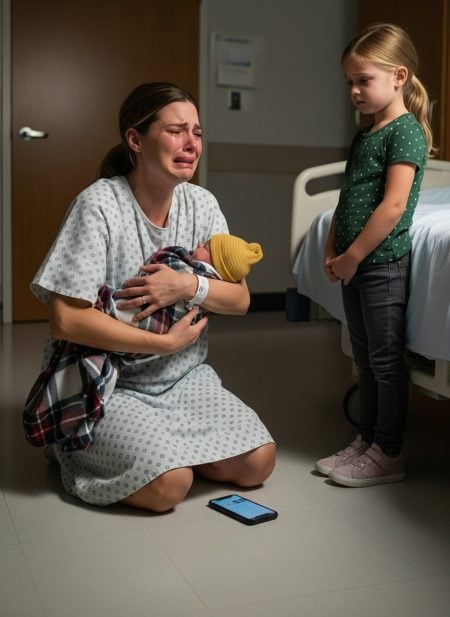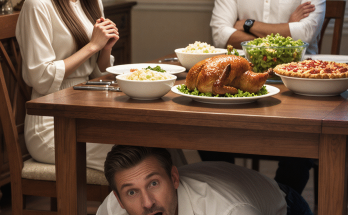The first thing Sarah noticed was the quiet. Not the hush that falls over a hospital at night, but a softer quiet, like the air holding its breath. Her newborn daughter slept against her chest, warm and impossibly small. The faint scent of lotion mixed with disinfectant. Monitors blinked. Somewhere down the hall a cart rattled past and a nurse laughed gently at a private joke. It was an ordinary evening in the maternity wing. Or at least it should have been.
Her husband, Mark, looked wrung out and happy. He was already choosing which photo to text to the grandparents, deciding between the one with the knitted hat or the wrinkled yawn. Their ten-year-old, Emily, stood at the window clutching her phone, looking as serious as a person far older than ten.
“Come see your sister, Em,” Sarah whispered. “She wants to meet the girl who made me a mom the first time.”
Emily didn’t move.
Instead she turned, eyes shiny, hands shaking. “Mom,” she said in a voice barely more than breath, “we can’t bring this baby home.”
Sarah felt the room tilt. “Honey, what are you talking about?”
Emily stepped forward and offered her phone like it was a fragile thing. “Please look.”
On the screen was a newborn in a pink blanket, lying in a bassinet that looked exactly like the one beside Sarah’s bed. The tiny wristband on that baby read: Olivia Grace Walker. The same name as the child sleeping on Sarah’s chest. The same hospital name along the band. The same birth date listed at the bottom of the hospital app.
Sarah’s knees softened like she might sink to the floor. “How is this possible?”
“I saw the nurse upload photos to the hospital’s portal,” Emily said, voice wobbling. “And then I saw this. It says Olivia Grace Walker. But that baby is not our Olivia.”
Mark tried to steady the air. “It has to be a clerical error. Two families, same name, same day. The system mixed up the photo.”
Maybe. Maybe not. Because there had been that stretch after delivery when the baby was whisked to the nursery for routine checks. It was supposed to be a few minutes. It had felt longer.
Sarah pulled her daughter closer with one arm and held her newborn with the other. Fear rose like a wave. “I want answers,” she said. “Now.”
When A Mother Becomes Her Child’s Advocate
The nurse on duty, Linda, had a smile that usually calmed worries. “It’s a database glitch,” she said lightly. “Hospitals see similar names all the time. The system spits out duplicates. We fix it, no harm done.”
“Was there another baby born here with the name Olivia Grace Walker?” Sarah asked, making sure the words came out steady.
“I can’t share information about other patients,” Linda said. “Privacy rules.”
“Then I want the protocols,” Sarah replied. “I want to know how you make sure the right baby is with the right mother. Footprints, ID bands, barcodes. I want to see it all.”
As a parent, Sarah had spent years learning to trust her instincts. She knew when a fever was just a fever and when it meant the pediatrician. She knew when a scraped knee needed a hug or a stitch. This feeling did not pass when people tried to soothe it. It sharpened.
Later, when the room had quieted and the corridor lights dimmed, Sarah opened the hospital portal herself. She typed Olivia Walker and scrolled through a long list of results. One entry matched exactly: Olivia Grace Walker, female, St. Mary’s Hospital, born May 4. Today. Here.
Access denied. Only authorized users could view details.
The next morning, Sarah met her obstetrician in the hall. “Dr. Patel, I need you to answer plainly,” she said. “Is there another Olivia Grace Walker born here yesterday?”
He paused in that careful way doctors do when they are weighing truth against policy. “Yes,” he said finally. “There was. Same name, same middle name. It happens, rarely.”
Sarah’s throat tightened. “Then show me how we know which baby is mine.”
“Your baby was always with our team,” he said. “There was no switch.”
Maybe. But mothers know the difference between reassurance and proof.
For readers who have been through a scare like this, you know that beyond the emotions there are practical tools that protect your family. Having a clear health insurance policy with access to the hospital portal, understanding how to request a medical consultation or formal review, and knowing you can ask to speak with a patient advocate are not luxuries. They are part of bringing a child safely home. If you have ever helped a grandchild or adult child through birth, you also know the comfort of clear protocols and the calm of someone explaining each step.
Two Babies, One Name, One Long Night
That afternoon Emily sat quietly beside the bed, holding her mother’s hand, as if the ten-year-old could keep the world from wobbling. “Mom,” she whispered, “I saw the other baby in the nursery window. She looks just like her.”
The sentence landed like a stone on still water. Same name. Same day. Same face. The coincidence felt too large to fit into coincidence.
When the ward grew still and the lullabies from phone speakers faded, Sarah slid her baby into the bassinet, pressed the call button, and asked to be wheeled to the nursery. A nurse hesitated, then nodded.
Under soft lights, the nursery looked peaceful, almost like a painting. Two bassinets next to each other, both with crisp little cards clipped to the side. Two names typed neatly: Walker, Olivia Grace. The room swam. Sarah gripped the rail until her knuckles blanched.
“Please take me back,” she said through her teeth. She kissed her baby’s forehead and tried to breathe.
Demanding Proof, Not Comfort
The following morning Sarah asked to meet someone from administration. Mr. Reynolds, the hospital administrator, ushered them into a small office with a neat stack of files and a plant that looked too perfect to be real.
“This is serious,” he began, hands folded. “We did register two infants under the same name last night. We have procedures for this. Footprints, digital ID scans, barcode bands, and when there is any question, DNA. There should be no chance of a permanent mix-up.”
“No chance?” Sarah heard her voice rise. “I saw two bassinets with the exact same name card. I need more than promises. I need proof.”
Mr. Reynolds glanced at Linda, then back at Sarah. “The label error was identified and corrected. Both infants are accounted for with proper ID bands. You are holding your child.”
“Test us,” Sarah said. “Test right now.”
Within the hour, a technician arrived. Tiny heel pricks. A gentle swab from inside the cheek. Samples from Sarah and Mark. One from the other baby’s parents as well. The technician explained the turnaround time and left with the folder against her chest like something precious.
The waiting was its own unique pain. Sarah held Olivia and studied the small face as if any difference could be learned by gaze alone. The soft down along the forehead. The small heart-shaped lip. The particular way her left hand unfurled when she sighed. She was certain and not certain in the same breath.
Emily pressed her head against her mother’s arm. “Even if something happened,” Emily said quietly, “we would still love her. Right?”
“We will love her always,” Sarah said. “And we will love the truth.”
The Envelope On The Desk
Two days later the phone rang. Results were ready. Sarah and Mark walked down the corridor hand in hand. Emily stayed with her grandmother who had arrived early that morning, putting on the kettle and tidying what did not need tidying, the way grandmothers do when they cannot fix a thing but they can make the house feel safe.
In the administrator’s office, the technician slid a folder across the desk. “DNA confirms that Baby A is biologically yours,” she said. “No evidence of a switch at any time.”
Relief came so swiftly it made Sarah lightheaded. Tears broke cleanly. She pressed her cheek against Olivia’s soft head. “You’re mine,” she whispered. “You were always mine.”
The technician waited, then added, “Baby B belongs to another couple, also confirmed. The duplicate name triggered a labeling error in the visual system. The barcoded wristbands were correct. The app pulled the wrong photo into the public stream. The error should never have happened.”
Mr. Reynolds nodded, measured. “We will complete a full review. Processes will be tightened. Parents will be updated. I am very sorry for the fear this caused.”
Sarah believed him. She also knew that systems are only as good as the people insisting they work. She looked at Emily. Her daughter’s chin lifted almost imperceptibly. See, her eyes said. I was not wrong.
Bringing A Baby Home, Bringing Calm Back To The House
They buckled Olivia into the car seat as if she were made of spun sugar. The first ride home is always a nervous one, but this one carried extra weight. At the front door, Mark paused to adjust the tiny hat once more. The house smelled like laundry and lemon cleaner. A vase of flowers waited on the counter. The bassinet in the corner looked both familiar and brand new.
That night, as the house settled, Sarah rocked in the dim light and felt the day melt off. “We are going to protect her,” she told Mark. “Not with fear. With good habits.”
They made a quiet plan, the kind that old friends and wise neighbors recommend, the kind many grandparents recognize from years of looking out for little ones.
They verified that both hospital ID bands matched the barcode on their discharge paperwork and the pediatrician’s intake form. They scheduled the first checkup before bedtime. They took photos of wristbands and papers and saved them to a shared folder with the insurance cards. They wrote down names: charge nurse, pediatrician, patient advocate. They saved the hospital’s patient portal credentials to a secure manager and reviewed their health insurance policy to be sure the newborn was fully added to the plan. They tested the baby monitor and checked the front door lock. They were not scared now. They were prepared.
The Memory That Doesn’t Fade, And The Good It Can Do
Weeks later, the birth story would be told with a different ending. The part where a ten-year-old became the person who noticed what the adults missed. The part where a mother decided that comfort could wait while certainty arrived. The part where a hospital said, We are sorry, and then showed exactly how they fixed the gap that let the fear in.
The image that visited Sarah at odd moments was not the moment of panic at the nursery window, though that was sharp. It was Olivia’s small hand uncurled like a fern in early light. It was Emily’s brave, trembling voice saying what needed to be said. It was Mark in the kitchen, warming a bottle and humming a song he could not quite remember. It was the tiny click when the front door locked at night.
Not every story ends this cleanly, and Sarah knew that. She also knew they were not going to live in what if. They were going to live in what is.
“Someday,” she told Emily, “you’ll tell your sister that you were the first one to protect her.”
Emily smiled, shy and proud. “She can borrow my phone,” she said. “But only when she is thirty.”
They laughed, and the house breathed again.
What To Remember When You Need Calm In A Crisis
If life ever puts you in a room where your heart lurches and the ground feels unsteady, hold onto this:
You have the right to ask for proof, not just reassurance. You have the right to request a patient advocate, to see protocols, to confirm IDs and request a medical consultation. You can keep copies, take photos of labels, and ask for names. You can add your newborn to your health insurance policy the same day, schedule the first pediatric visit before you leave the hospital, and keep a simple list of contacts on the fridge. And when you bring that baby home, you can make your world calmer with practical tools like a reliable baby monitor and, for overall peace of mind, a well-maintained home security system that helps everyone sleep.
Most importantly, trust your good sense. The instinct that got you through a thousand ordinary days will carry you through the extraordinary ones too.
That night, Sarah kissed both daughters. One old enough to save the day with a sentence, one newly here and wrapped like a small star. She turned off the light and listened to the soft rhythm of a house that had found its balance again.



